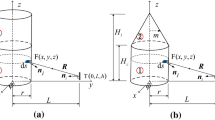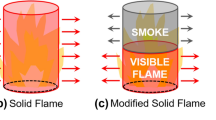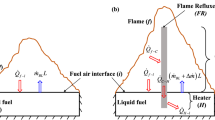Abstract
A simple model that divides the heat flux to the bodies engulfed in a diffusion flame into different components, namely radiation and convection is studied. Different sizes of brass and stainless steel (SS 304L) rods varying from 25.4 mm to 50.8 mm in length and 25.4 mm in diameter are used as specimens in this study. Experiments are conducted with each body inside a diesel pool fire of different diameters, namely 0.5 m, 0.7 m and 1.0 m. The temperature history of the body engulfed in a pool fire is measured to compute the thermal energy absorbed by the lumped body. Using an energy balance, the total energy is divided into three different components. The gas velocity in the flame is measured to be 1.53 m/s to 1.79 m/s for the diesel pool fires of 0.5 m to 1.0 m in diameter. The dominant mode of heat transfer in this study is radiative in nature. This simple model is reasonably able to predict the heat flux incident on to the lumped bodies engulfed by diesel pool fires using the measured temperature history. A three dimensional formulation for an axi-symmetric pool fire of a measured flame shape, flame temperature and a gray flame absorption coefficient is employed to predict the temperature of the body engulfed in pool fires. This formulation has to be modified to capture the absolute temperature values of the flame.












Similar content being viewed by others
Abbreviations
- A s :
-
Surface area (m2)
- Bi:
-
Biot number
- C p :
-
Specific heat capacity (kJ/kg K)
- D :
-
Diameter of the body (m)
- D :
-
Pool diameter (m)
- D e :
-
Characteristic length (m)
- F view :
-
Configuration factor
- H :
-
Height of the body (m)
- h 1 :
-
Distance between dV and dA along the pool axis (m)
- h fs :
-
Convective heat transfer coefficient (W/m2K)
- K :
-
Thermal conductivity (W/mK)
- Nu:
-
Nusselt number
- P :
-
Pressure (Pa)
- Pr:
-
Prandtl number
- q” :
-
Heat flux (kW/m2)
- Re:
-
Reynolds number basing on characteristic length
- S :
-
Distance between dV and dA (m)
- T :
-
Absolute temperature (K)
- T :
-
Time (s)
- T ∞ :
-
Atmospheric temperature (K)
- T f :
-
Flame temperature (K)
- T s :
-
Black body temperature (K)
- U :
-
Gas velocity (m/s)
- V :
-
Volume (m3)
- ε f :
-
Flame emissivity
- ε s :
-
Flame emissivity specimen
- φ :
-
Inclination of dA with respect to dV
- ρ :
-
Density (kg/m3)
- σ :
-
Stefan–Boltzmann constant
- ν :
-
Kinematic viscosity (m2/s)
- D :
-
Diameter of the pitot tube (m)
- Sto :
-
Stored
References
Rashbash DJ, Rogowski ZW, Stark GWV (1956) Properties of fires of liquids. Fuel 35:94–107
McCaffrey BJ (1979) Purely bouyant diffusion flames: some experimental results. NBSIR 79-1910, National Bureau of Standards
Schneider ME, Kent LA (1989) Measurements of gas velocities and temperatures in a large open pool fire. Fire Technol 25:51–80
Qian C, Saito K (1995) Measurements of pool-fire temperature using IR technique. Combustion and Fire Research Laboratory, In: Gore JP (ed), Joint Technical Meeting. Proceedings, Combustion Fundamentals and Applications. San Antonio, TX, pp 81–86
Cuchi EP, Chatris JM, Carlos L, Arnaldos J (2003) Determination of flame emissivity in hydrocarbon pool fires using infrared thermography. Fire Technol 39, 261–273
Sudheer S, Prabhu SV (2012) Measurement of flame emissivity of hydrocarbon pool fires. Fire Technol 48:183–217
Cumber SP (2011) Measuring radiation heat fluxes from a jet fire using a lumped capacitance model. Fire Technol 47:665–685
Logenbaugh RS, Sanchez LC, Mahoney AR (1990) Thermal response of a small scale cask-like test article to three different high temperature environments. Sandia National Laboratories Report to Federal Rail Administration DOT/FRA/ORD-90/01
Kramer MA, Greiner M, Koski JA, Lopez C, Suo-Antitila A (2003) Measurements of ehat transfer to a massive cylindrical calorimeter engulfed in a circular pool fire. J Heat Transf 125:21–40
Nakos JT (2005) Uncertainty analysis of steady state incident heat flux measurements in hydrocarbon fuel fires. Sandia National Laboratories SAND2005-7 144
Ahmadi MAH, Hashemabadi SH (2008) CFD based evaluation of heat transfer coefficient from cylindrical particles. Int Commun Heat Mass 35:678–680
Hadad Y, Jafarpur K (2011) Laminar forced convection heat transfer from isothermal cylinders with active ends and different aspect ratios in axial air flows. Int J Heat Mass Transf 47:59–68
Morgan VT (1975) The overall convective heat transfer from smooth circular cylinders. Advances in heat transfer. Academic Press, London
Chatris JM, Quintela J, Folc J, Planas E, Arnaklos J, Casak J (2001) Experimental study of burning rate in hydrocarbon pool fires. Combust Flame 126:1373–1383
McCaffrey BJ, Heskestad G (1976) A robust bidirectional low-velocity probe for flame and fire application. Combust Flame 26:125–127
Bryant RA (2009) A comparison of gas velocity measurements in a full-scale enclosure fire. Fire Saf J 44:793–800
Janssens ML (1991) Measuring rate of heat release by oxygen consumption. Fire Technol 27:234–249
Incropera F, DeWitt D (2002) Fundamentals of heat and mass transfer. Wiley Inc., New York
Babrauskas V, Peacock RD (1992) Heat release rate: the single most important variable in fire hazard. Fire Saf J 18:255–272
Tunc M, Venart J (1984) Incident radiation from an engulfing pool fire to a horizontal cylinder—part I. Fire Saf J 8:81–87
Author information
Authors and Affiliations
Corresponding author
Rights and permissions
About this article
Cite this article
Sudheer, S., Prabhu, S.V. Partitioning of Convective and Radiative Heat Fluxes Absorbed by a Lumped Body Engulfed in a Diffusion Flame. Fire Technol 51, 801–822 (2015). https://doi.org/10.1007/s10694-014-0412-7
Received:
Accepted:
Published:
Issue Date:
DOI: https://doi.org/10.1007/s10694-014-0412-7




